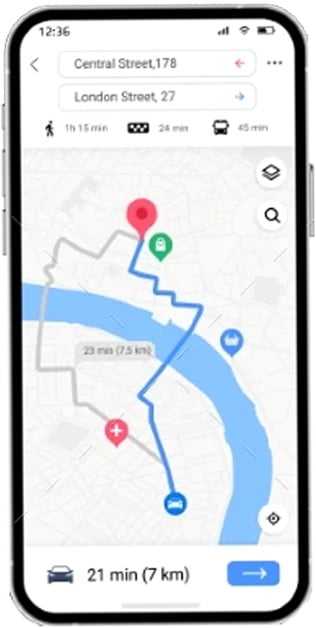10 Hidden Tricks for Google Maps on Android. Who doesn’t enjoy using Google Maps? The Maps Android software assists those of us with oatmeal brains in finding our way around without having to fire any neurons or stretch any synapses. It even assists us in locating locations where we may get delectable cuisine, such as, oh, oats (yum!).
Table of Contents
10 Hidden Tricks for Google Maps on Android
But there’s a lot more to Google Maps than meets the eye – and chances are, you’re missing out on at least a few useful hidden features hidden within the Maps Android app. With Android 12 just around the corner and more sparkling new Android goodies appearing by the day, I thought now would be a good time to delve deep into this ever-evolving Android anchor and consider some of its more off-the-beaten-path sophisticated settings.
Take a couple of minutes the next time you have Maps open on your phone to explore these options, and prepare to experience the world around you in a whole new way. 10 Hidden Tricks for Google Maps on Android.

List of 10 Hidden Tricks for Google Maps
1. Permanent dark mode
In the same “Navigation settings” area of Maps’ settings, anyone with sensitive eyes will be glad to discover an understated option: the ability to switch Maps’ color scheme to a permanent dark mode while navigation is enabled.
Maps manage this option on its own by default, switching between a light and dark scheme as it sees fit. If you like to avoid distracting colors all the time, go for the “Color scheme” choice and change it from “Automatic” to “Night.”
2. Location sharing
Next, hit the blue location dot within the main Maps screen and then select “Share location” from the menu that appears to help someone find you — or maybe just give ’em an update on your locations and progress.
This allows you to send anyone a link that allows them to track your location in real-time on a map for a set period of time or until you disable the feature. You can even beam the link into some other app or service on your smartphone to get it where you need it.
3. Pinned places
Do you find yourself frequently going to the same areas or taking the same long drives? You can save time by using Maps’ often-overlooked trip pinning mechanism. It allows you to save frequent excursions and then immediately bring them up for on-demand, hassle-free navigation anytime you need it.
You can pin a journey from several locations within the Android Maps app:
- When you’re looking for a specific location in the Maps app, look for the Pin command at the bottom of the screen after you’ve tapped the button to get instructions.
- Tap the Go option at the bottom of the main Maps screen, then look at the app’s suggested areas based on your previous activity. If you see a trip you want, tap the pushpin icon next to it to save it.
Anything you choose, whatever you’ve pinned will always appear at the top of the app’s Go tab from then on – and starting new navigation to that location will only be one more tap away.
4. Location saving
Remember when one of the most popular Android applications was a simple little tool called Car Locator? No? Well, I do – but then again, I’ve been blogging about Android for 973 years. (Related: I might be a wise, if slightly withered, tortoise elder.)
That program is no longer available – but here’s a little-known fact: Maps can do precisely what it used to do and remember any spot you like, then help you meander back to it later.
Open Maps and tap the blue dot that symbolizes your current location the next time your brain needs a memory boost. This will bring up a huge ol’ honkin’ menu, where you’ll find the immensely handy “Save parking” option. (And don’t be fooled: while the feature’s official purpose is parking, you can use it to record any kind of location for any reason you like.)
Simply select that option, and you’re done: Maps will store your current position in its memory. Swipe up on the bar at the bottom of the screen that says “Parking location” if you want to add more information to help your own squishy mammal brain later.
You can then add notes about your saved location (what level you parked on, how many oatmeal-serving establishments were nearby, and so on), attach photos (you making goofy faces in front of numerous passers-by, and so on), and set an alert to remind you about location until a certain amount of time has passed.
When you’re ready to return to your car – or whatever type of parking spot you’ve reserved – all you have to do is press the same “Parking location” bar at the bottom of the Maps app or search for the “Parking location” notification from anywhere on your phone.
5. Instant driving mode
Google Maps and Assistant now collaborate to provide a driving mode that puts common mid-trip functions front and center and makes them as easy to access while driving as possible.
By default, the model appears whenever you initiate a new Maps navigation. However, with a few simple changes, you can make it even handier by instructing it to start up on its own whenever you connect to your vehicle’s Bluetooth connection – or even simply when it detects that you’re driving.
Tap your profile image in the upper-right corner of the Maps Android app, then click “Settings,” then “Navigation settings,” and finally “Google Assistant settings” (whew!).
Examine the lines labeled “When linked to car’s Bluetooth” and “When driving is detected” on the following screen. In the first situation, you may direct Maps to launch driving mode immediately after establishing a connection – or you can instruct it to display a prompt and ask if you want this to happen every time such a connection is formed. Beyond the default “do nothing” action, the pop-up prompt is your only option on the auto-driving detection.
And one more thing to remember: if you ever would like to summon driving mode with your own, you can always activate Assistant (by saying “Hey Google” or whatever Assistant-summoning command you prefer) and then say “driving mode” – or you can start giving yourself a one-touch click for trying to launch the mode by long-pressing on one’s home screen, selecting “Widgets,” trying to scroll to the Maps section, and touching and holding the “Driving Mode” widget to place it
6. Incognito mode
You’re on your way to a hidden lair, aren’t you? Take a look at yourself, Bruce Wayne. Save the following information to your amygdala: If you tap your profile picture in the Maps app and then pick “Turn on Incognito mode,” Maps will temporarily stop saving and using your location for future purposes. And no one will know where you are, not even Google.
Don’t worry: I’ll keep your secret safe.
7. Location collections
One of the most unappreciated features of the Android Maps app is the ability to make collections of places and then revisit or share them with other human person-people later. It’s like a hyper-targeted bookmarking service that’s all about locations and is directly linked to your favorite navigation genie.
To use the system, go to the Saved tab at the bottom of the Maps app and look for the part labeled “Your list.” Within that part of the screen, tap the “New list” instruction, and you can then give your new shiny list a name and a description, as well as choose whether you want it to be private, shared just with specific people, or public for anyone to find.
You may also choose to allow others to modify and add their own items to shared lists, making it a simple way to work with colleagues, cousins, even chinchillas on a list of lust-worthy lunch venues or places to stop by on your next business outing.
8. In-app media controls
Why should you have to swipe around to manage your music when you can do it straight from the Maps interface? Maps has the capability of integrating music controls right into the app, allowing you to see your currently playing tunes and shuffle them around as needed within a prominently positioned bar in the app’s navigation section.
To begin, go to Maps’ settings, then to “Navigation settings,” then to “Assistant default media provider.” Choose one of the offered alternatives, and the service you select will appear on your navigation interface as well as reply to any spoken commands sent to Assistant regarding audio playback.
9. Locked orientation
It appears that it would be easier to interpret a map if the north was always looking up. So, good news, my fellow orientation-obsessed organism: you can instruct Maps to maintain a continuous, locked orientation with north at the top anytime it’s navigating. Simply go to the app’s main settings and seek the option called (very appropriately) “Keep map north up.” Activate it, and you’ll never have to perform that awkward head-pivoting, trying-to-figure-out-which-way-you’re-facing maneuver again.
10. Automated trip organization
Back in 2016, Google released Trips, an incredibly innovative software. Trips automatically produced beautifully organized, easy-to-manage bundles of plans from your incoming itineraries and confirmations by tapping into all the information currently in your email. It. Was. Awe-inspiring.
But then, well, Google did its thing. After only a few years, the firm canceled Trips, leaving those of us who had come to rely on its intelligence stranded, with no similar substitute.
Or so it appeared. Today, much of Trips’ planning intelligence has discreetly found its way into the main Maps app. You’ll almost certainly need a map to find it.
Now and here is the deal: On Android, open the Maps app, press the Saved tab at the bottom, and then scroll down to find the circular Reservations button. Tap that, and any flights, car rentals, meal reservations, or other travel-related plans you have will appear in an ordered list gathered directly from confirmations in your Gmail inbox and Google Calendar.
Do you want to reminisce about former adventures? You have it: Simply tap your profile image in Maps’ upper-right corner, then choose “Your Timeline” from the menu that appears, and look for the term “Trips” on the top-of-the-screen bar. There, in that tucked-away location that no normal person would ever locate, you’ll find complete information about any wanderings Google has accumulated over the years.
Also, if you don’t want this information transferred over from other Google services into the Maps app, you can block it or limit how far back it goes by turning off or limiting Web & App Activity in your Google privacy settings.





